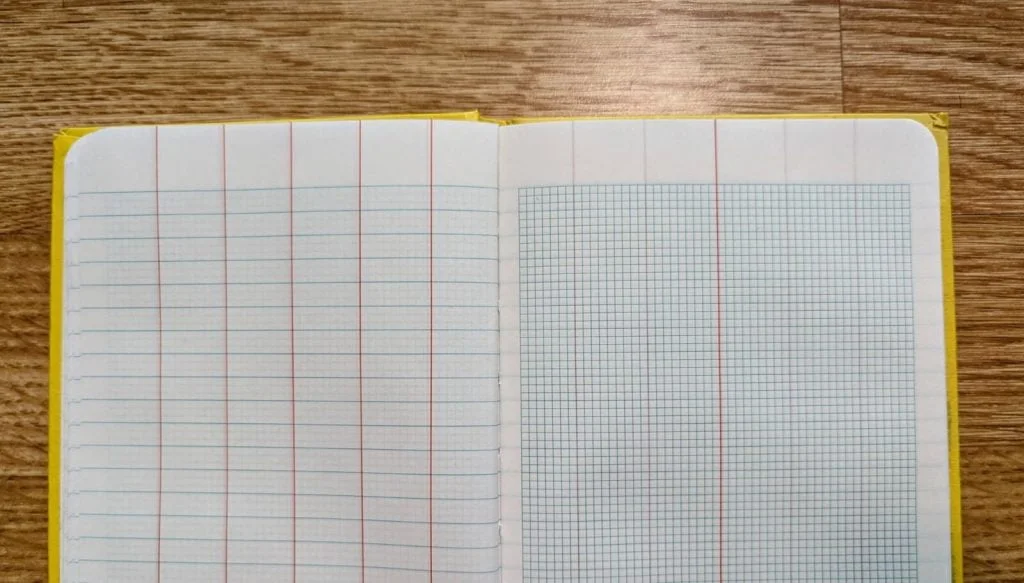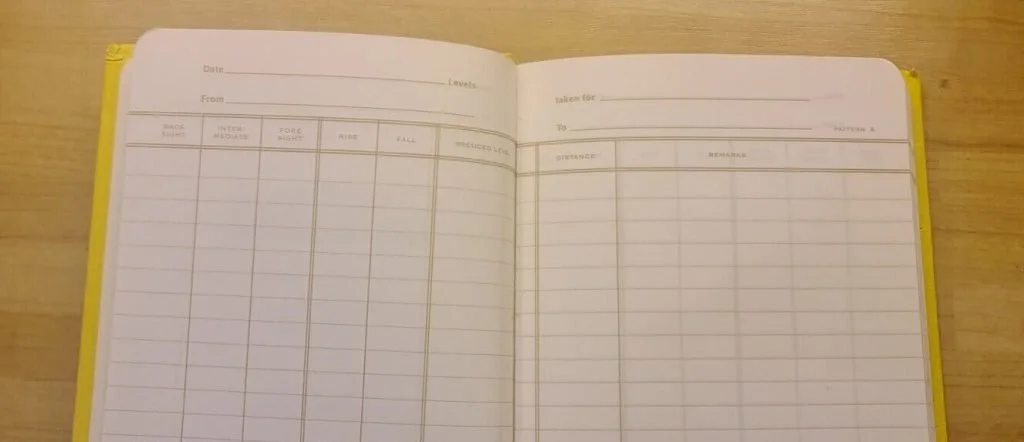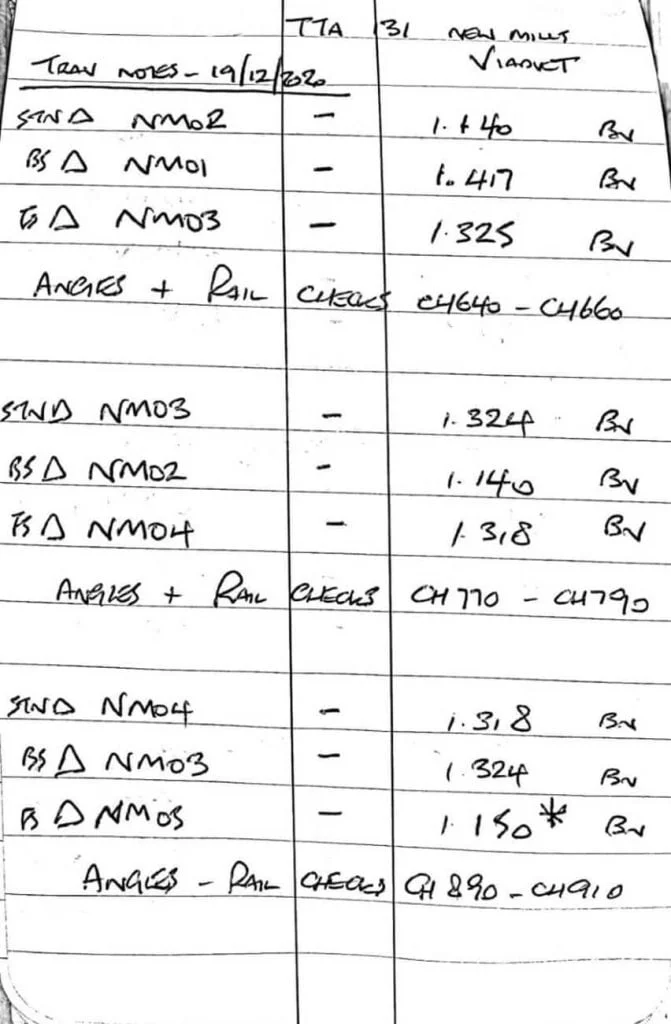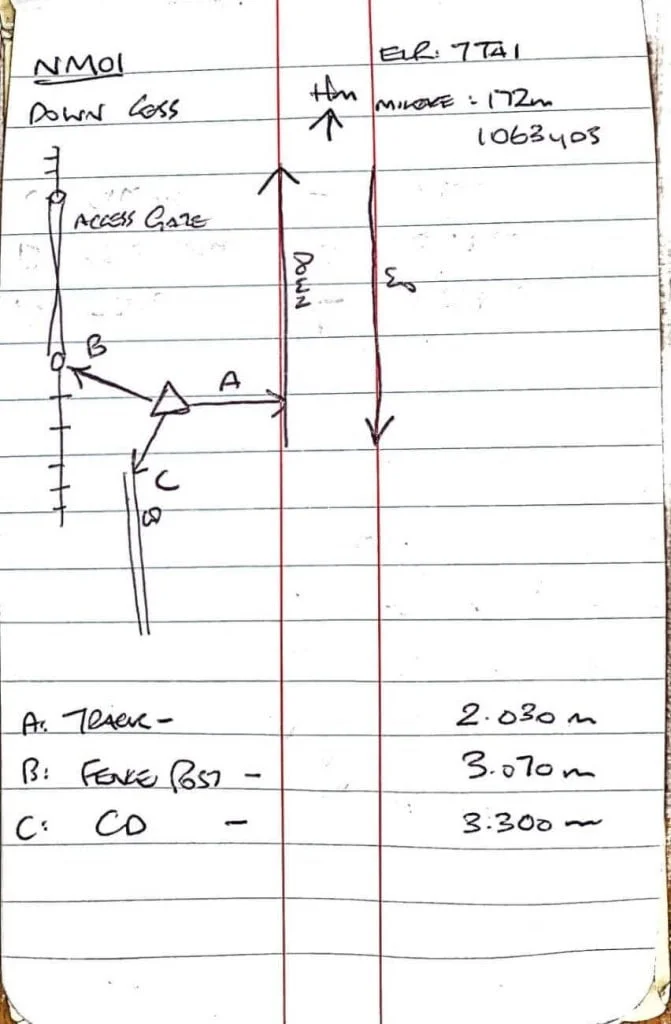Surveying is all about observations. When you go on site, you often need to record not just topographical data, but also notes about your work. Good record keeping is a must have in land surveying, and this is best achieved by always taking essential field notes in your survey field book.
What is a field survey book?
A survey field book, also called a survey log book, is an essential site accessory that shouldn’t be missing from any surveyor’s pocket. They come in many shapes and sizes and are usually made for a specific purpose (e.g. to record fall & rise in levelling).
Although any sort of notebook you can write notes in can be used as a surveyor’s field book, it’s better if you go for the ones which are made specifically for surveying.
Dedicated field books for surveying (and site notes in general) are specially made to withstand harsher environments. They usually have a durable cover and use a high quality paper with a high cotton content which gives good tear resistance when wet.
Pages are usually printed in permanent ink and are sewn in a rot proof thread which makes them ideal in unpredictable weather environments or in tough site conditions. Even after being subjected to adverse site or weather conditions, field survey books retain their strength and writing surface.
Types of field books in surveying
As with anything in life, there are different types of field books made for surveying. They can be categorised by a multitude of factors. However, I believe these are best sorted by their use.
Depending on how you use your survey log book, this can be bundled in one of three categories: general purpose, levelling and dimensions.
General purpose survey field books
These types of field books books usually have blank pages or simple ruled (or lined) pages. They are a good all rounder when your job involves a variety of note-taking tasks.
Any pocket-size notebook can be used as a general purpose field book. However, bear in mind the observations above if you typically work in generally rainy environments.

Levelling survey field books
Levelling field books come with pages printed in a very specific format. They are ideal for recording rise and fall data and collimation or H.P.C (Height of Plane of Collimation).
A typical levelling survey field book will have pairs of pages where you can record information about the job and measurements for the task. These are typically split in a header and a body.

The header of pages in a levelling book usually has fields where you can record:
- Surveyor taking the notes
- Date of the survey
- Instrument type and details
- Weather description
- Location
- Team
- Project
The body of pages in a levelling book typically has a table with the following columns:
- Backsight
- Intermediate
- Foresight
- Rise & Fall (or collimation)
- Reduced level
- Distance
- Remarks or comments
If your job involves a lot of levelling, this is probably the best choice for you as it’ll help you take levelling records in a consistent format.
Dimension survey field books
A dimension field book is typically has ruled lines, with numbering incrementing with each page opening. These best used when recording dimension data. In general, the pages do not have a lot of printed patterns, so they can be used for other purposes easily.

Just because surveying field books come in a variety of shapes, sizes and use cases, that doesn’t mean you should have one of each with you all the time. You’re generally better off with having just one.
Choose the type that’s most useful for you (e.g. a levelling book if you do a lot of levelling) and repurpose the pages whenever you need to take different notes.
What field notes should do you take?
There isn’t a strict set of requirements for what data is recorded in survey field books. Just think of it as record keeping of what you do in the field.
Aside from the observations you must include when doing a specialised task (e.g. levelling), you can write anything in it that is relevant to your job. You should use them to write notes and details of time, date, activities, settings, behavior and conversations in the field.
Field notes keep track of observations that you generally tend to forget over time. They also help create a site report when these are required by the job.
In addition to any notes you write in them, they are also useful to do site sketches, location plans or witness diagram sketches.
It’s your choice what you note down in your survey field book. I usually take the approach of thinking that my field data will be processed by someone else who wasn’t in the field. So I try to be as specific as possible in order to produce a descriptive image of the site situation.
When taking field survey notes, keep in mind that they should serve three main functions:
- Description. They are notes of your day on site, so record any date & times relevant to you, activities, settings, observations etc. Field notes should be taken in order to supplement your survey data.
- Interpretation. Your field notes should allow you to examine the subjective aspects of your field work. When you write your field notes, write your interpretations of what you encounter in the field. This should be done in a distinct way from the descriptive content.
- Reflection. These should contain your thoughts, ideas, questions and concerns about the task at hand.
Example – Control Network Survey
For example, if I go on site to do a control network installation survey I would write in my field book the following:
- Details relevant to the task I’m doing:
- Setup details: point names for setup, backsight and foresight(s), instrument & target heights & prism constants, instrument used, residuals etc.
- Traverse / control network sketch
- Witness diagrams sketches for each point
- Shift details for site report which would include:
- Site arrival and departure time
- Team members & tasks
- Difficulties encountered (access restrictions, instrument malfunctions, site conditions etc)
- Overall progress achieved
How to write good field notes in a surveyor’s field book
Writing down quality field notes in your survey log book is essential if you want to have a good recollection of your site activity. Below are a few tips on how to improve your note-taking skills on site.
Do it as soon as possible
Try to write your notes as soon as you can, otherwise you might omit essential data or critical facts about your fieldwork activity.
Even if you take just quick notes in a shorthand notation, you can expand on them later if essential data is captured in them (e.g. instrument heights).
Be descriptive
Try and capture the details of your activity in a descriptive manner. Writing a number on a page is of no use if you do not describe the meaning of it.
Explain more complex tasks or any difficulties you have in enough words to make sense
Be accurate
Accuracy is critical in the surveying profession. Written field notes should contain accurate information about the recorded observations. If you’re writing down measurements make sure you note down to the significant number of digits.
When dealing with non-numerical data, make sure the notes reflect the situation in the field as best as possible.
Be well organised
If you want to take high quality field notes on site, you should plan ahead and organise your note-taking in accordance with your task at hand. Do not mix irrelevant data on the same page and organise them in such a way that someone who wasn’t on site can read them and understand your activity, like reading a story.
Stay on point
Don’t overdo it with irrelevant data or too much information. You don’t have to explain every single step in a process unless you want to spend your whole time writing notes. Include only the most important details about your field work.
Also, grocery shopping lists and doodles should probably be excluded from your survey book 🙂.
Add your insights and thoughts
Think about the meaning of what you observe and add your personal thoughts and ideas. These might help you explain difficulties encountered on site and update your plans for future shifts accordingly.
Add notes in your survey field book about site conditions, hazards and insights on them. Anything you might want to remember for the office side of things or that you want to pass onto anyone going back on site.
Supplement with other type of records
If a picture is worth a thousand words, then a video is worth a million
YouTube Blog
Written notes can only go so far in providing a clear and insightful explanation. Always supplement your survey field notes with sketches, photos or even videos to provide a better picture of the information you want to convey.



